When it comes to compact SUVs, the Hyundai Kona and Kia Sportage stand out as two compelling options in the market. Both vehicles are designed to cater to modern drivers' needs, offering a blend of performance, innovation, and technology. In this comparison, we delve into the specifications, features, and unique aspects of both models to help you make an informed decision.
Hyundai Kona vs Kia Sportage – Which one offers the better deal?
Both models have their strengths – but which one suits you more?
Compare performance, efficiency, price and space directly: Hyundai Kona or Kia Sportage?
Design and Dimensions
The Hyundai Kona measures 4,350 mm in length, while the Kia Sportage is slightly larger at 4,515 mm. The Sportage also boasts a wider stance at 1,865 mm compared to the Kona's 1,825 mm, which may offer a more stable ride. Both models feature a five-door, five-seat setup, with the Kona offering a trunk capacity of 466 liters and the Sportage providing up to 587 liters of storage space, making the Kia a better option for those needing extra cargo room.
Engine Options and Performance
The Kona offers a diverse range of engine types, including petrol, full hybrid, and electric options, with power outputs ranging from 100 HP to 218 HP. The Sportage also features a variety of engine types, including diesel and hybrid configurations, with power outputs reaching as high as 252 HP for the petrol variant. Both SUVs provide manual and automatic transmission options, yet the Sportage’s acceleration capabilities are impressive, with the fastest variant going from 0 to 100 km/h in just 8.3 seconds, while the Kona's fastest version achieves the same in 7.8 seconds.
Fuel Efficiency
Fuel economy is a significant factor for many buyers, and here both models excel. The Kona's petrol engines provide consumption values between 4.5 to 6.7 L/100 km, while the hybrid options offer even further fuel efficiency. In contrast, the Sportage delivers an impressive range of 5.0 to 7.2 L/100 km depending on the engine choice. For eco-conscious drivers, the Kona’s electric version boasts a range of up to 514 km on a full charge, while the Sportage's hybrid variants, while not as extensive in electric range, offer an efficient solution for daily driving.
Technology and Innovations
Both models are equipped with cutting-edge technology that caters to modern-day expectations. The Kona features an intuitive infotainment system compatible with Apple CarPlay and Android Auto, allowing for seamless smartphone integration. The Kia Sportage also offers similar technology perks, with an emphasis on advanced safety features, including lane keep assist and smart cruise control, enhancing the driving experience.
Safety Ratings
Safety is paramount in both vehicles. The Kona comes with numerous safety features and has been rated highly in crash tests, offering peace of mind to its drivers. Meanwhile, the Sportage has embedded advanced safety technologies like blind-spot monitoring and rear cross-traffic alert, which further bolster its safety reputation. These innovations reflect both brands' commitment to passenger safety.
Interior Comfort and Features
Inside, both have a modern, driver-centric layout but with different character traits. The Kona has a sportier feel with its design and layout, while the Sportage leans towards a more elegant and spacious interior, providing ample legroom and headspace. Both vehicles offer premium upholstery options, with Kia leaning into luxury with its higher trims featuring leather seating and a panoramic sunroof for that added touch of opulence.
Conclusion
In summary, the Hyundai Kona and Kia Sportage both present excellent choices for buyers in the compact SUV market. The Kona excels with its electric variant and sporty performance, making it a great option for urban drivers looking for efficiency. On the other hand, the Kia Sportage shines with its space, power options, and advanced safety features, appealing more to families or those needing versatile cargo capabilities. The decision ultimately hinges on personal preferences regarding performance, space, and technology. Regardless of choice, both models underscore the remarkable innovations of Hyundai and Kia in today's automotive landscape.
Here’s where it gets real: The technical differences in detail
Costs and Efficiency:
Price and efficiency are key factors when choosing a car – and this is often where the real differences emerge.
Hyundai Kona has a noticeable advantage in terms of price – it starts at 23100 £, while the Kia Sportage costs 30200 £. That’s a price difference of around 7105 £.
Fuel consumption also shows a difference: Hyundai Kona manages with 4.60 L and is therefore slight more efficient than the Kia Sportage with 5 L. The difference is about 0.40 L per 100 km.
Engine and Performance:
Power, torque and acceleration say a lot about how a car feels on the road. This is where you see which model delivers more driving dynamics.
When it comes to engine power, the Kia Sportage has a slight edge – offering 239 HP compared to 218 HP. That’s roughly 21 HP more horsepower.
In acceleration from 0 to 100 km/h, the Hyundai Kona is minimal quicker – completing the sprint in 7.80 s, while the Kia Sportage takes 7.90 s. That’s about 0.10 s faster.
In terms of top speed, the Hyundai Kona performs barely noticeable better – reaching 210 km/h, while the Kia Sportage tops out at 203 km/h. The difference is around 7 km/h.
There’s also a difference in torque: Kia Sportage pulls slightly stronger with 320 Nm compared to 265 Nm. That’s about 55 Nm difference.
Space and Everyday Use:
Whether family car or daily driver – which one offers more room, flexibility and comfort?
Both vehicles offer seating for 5 people.
In curb weight, Hyundai Kona is slightly lighter – 1370 kg compared to 1552 kg. The difference is around 182 kg.
In terms of boot space, the Kia Sportage offers noticeable more room – 587 L compared to 466 L. That’s a difference of about 121 L.
In maximum load capacity, the Kia Sportage performs clearly perceptible better – up to 1776 L, which is about 476 L more than the Hyundai Kona.
When it comes to payload, Kia Sportage somewhat takes the win – 580 kg compared to 490 kg. That’s a difference of about 90 kg.
Who comes out on top?
Overall, the Kia Sportage shows itself to be wins solidly and secures the title of DriveDuel Champion.
It convinces with the more balanced overall package and proves to be the more versatile choice for everyday use.
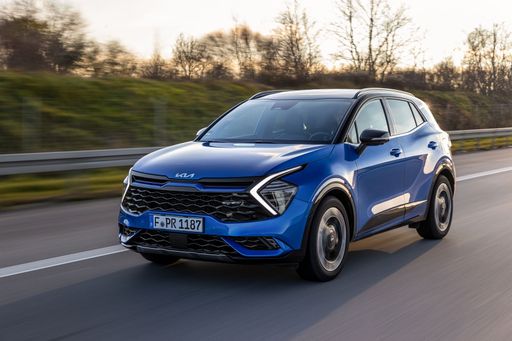 @ Kia Corporation
@ Kia Corporation
Kia Sportage
Hyundai Kona
The Hyundai Kona wears its personality on the outside with bold styling and sprightly handling that turns city driving into something a little more fun than a commute. It blends practical space, modern tech and sensible running costs into a compact, stylish package — a smart pick if you want flair without paying luxury prices.
details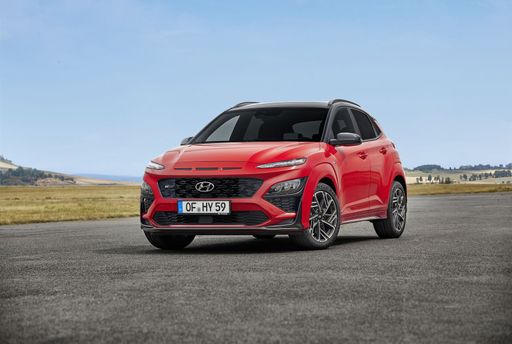 @ Hyundai Motor Company
@ Hyundai Motor Company
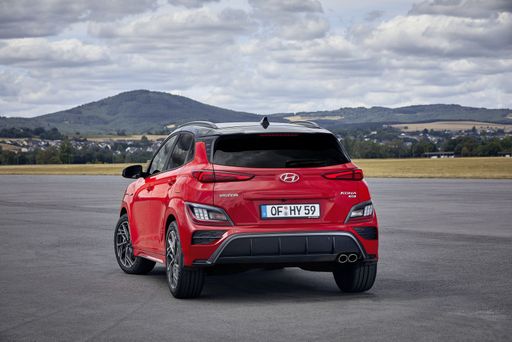 @ Hyundai Motor Company
@ Hyundai Motor Company
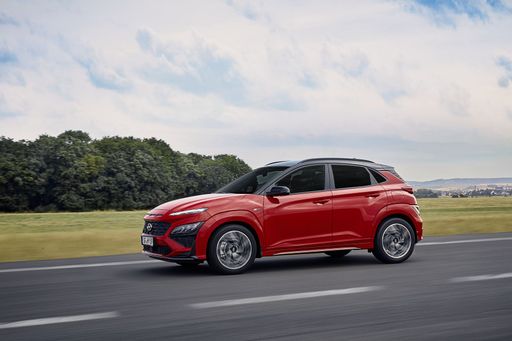 @ Hyundai Motor Company
@ Hyundai Motor Company
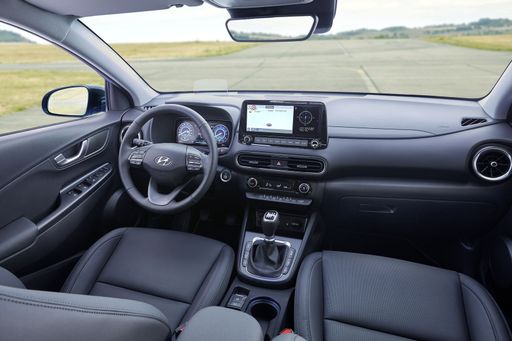 @ Hyundai Motor Company
@ Hyundai Motor Company
Kia Sportage
The Kia Sportage proves you don't have to choose between style and sensible family motoring, wrapping modern, confident looks around a roomy, well-equipped cabin. It's an easy car to live with — comfortable on daily runs, pleasantly engaging when you want a bit of fun, and kind to your wallet so you can keep smiling at the fuel pump.
details @ Kia Corporation
@ Kia Corporation
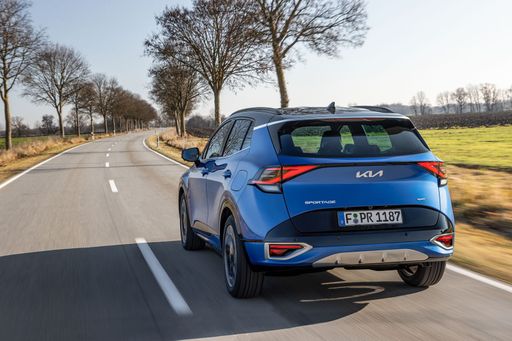 @ Kia Corporation
@ Kia Corporation
 @ Kia Corporation
@ Kia Corporation
 @ Kia Corporation
@ Kia Corporation
 @ Hyundai Motor Company
@ Hyundai Motor Company
|
 @ Kia Corporation
@ Kia Corporation
|
|
|
|
Costs and Consumption |
|
|---|---|
|
Price
23100 - 41600 £
|
Price
30200 - 43900 £
|
|
Consumption L/100km
4.6 - 7 L
|
Consumption L/100km
5 - 7.9 L
|
|
Consumption kWh/100km
14.6 - 16.8 kWh
|
Consumption kWh/100km
-
|
|
Electric Range
377 - 514 km
|
Electric Range
-
|
|
Battery Capacity
1.3 - 65.4 kWh
|
Battery Capacity
-
|
|
co2
0 - 163 g/km
|
co2
132 - 180 g/km
|
|
Fuel tank capacity
38 - 47 L
|
Fuel tank capacity
52 - 54 L
|
Dimensions and Body |
|
|---|---|
|
Body Type
SUV
|
Body Type
SUV
|
|
Seats
5
|
Seats
5
|
|
Doors
5
|
Doors
5
|
|
Curb weight
1370 - 1773 kg
|
Curb weight
1552 - 1733 kg
|
|
Trunk capacity
466 L
|
Trunk capacity
526 - 587 L
|
|
Length
4350 - 4385 mm
|
Length
4540 mm
|
|
Width
1825 mm
|
Width
1865 mm
|
|
Height
1580 - 1585 mm
|
Height
1645 mm
|
|
Max trunk capacity
1300 L
|
Max trunk capacity
1715 - 1776 L
|
|
Payload
420 - 490 kg
|
Payload
543 - 580 kg
|
Engine and Performance |
|
|---|---|
|
Engine Type
Electric, Petrol, Full Hybrid
|
Engine Type
Petrol, Full Hybrid, Diesel MHEV
|
|
Transmission
Automatic, Manuel
|
Transmission
Manuel, Automatic
|
|
Transmission Detail
Reduction Gearbox, Manual Gearbox, Dual-Clutch Automatic
|
Transmission Detail
Manual Gearbox, Dual-Clutch Automatic, Automatic Gearbox
|
|
Drive Type
Front-Wheel Drive, All-Wheel Drive
|
Drive Type
Front-Wheel Drive, All-Wheel Drive
|
|
Power HP
115 - 218 HP
|
Power HP
136 - 239 HP
|
|
Acceleration 0-100km/h
7.8 - 11.9 s
|
Acceleration 0-100km/h
7.9 - 11.6 s
|
|
Max Speed
162 - 210 km/h
|
Max Speed
180 - 203 km/h
|
|
Torque
200 - 265 Nm
|
Torque
250 - 320 Nm
|
|
Number of Cylinders
3 - 4
|
Number of Cylinders
4
|
|
Power kW
85 - 160 kW
|
Power kW
100 - 176 kW
|
|
Engine capacity
998 - 1598 cm3
|
Engine capacity
1598 cm3
|
General |
|
|---|---|
|
Model Year
2024 - 2025
|
Model Year
2025
|
|
CO2 Efficiency Class
A, D, C, E, F
|
CO2 Efficiency Class
F, D, E, G
|
|
Brand
Hyundai
|
Brand
Kia
|
Is the Hyundai Kona offered with different drivetrains?
Available configurations include Front-Wheel Drive or All-Wheel Drive.
The prices and data displayed are estimates based on German list prices and may vary by country. This information is not legally binding.
